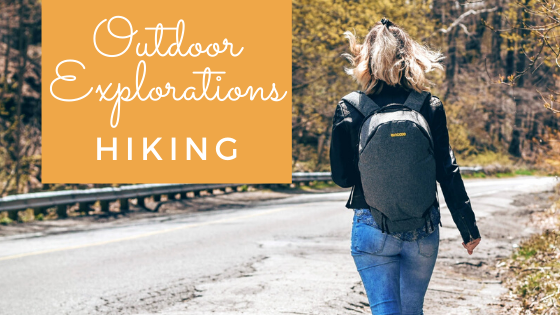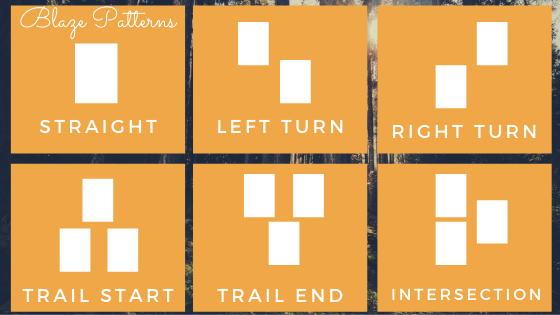
Have you ever considered taking up hiking as a hobby? Hiking is an easy and comparatively affordable way to enjoy the great outdoors along with family and friends. Beginner hikers starting out on shorter trails need only a sturdy, comfortable pair of athletic shoes; comfortable athletic clothing; and a properly-adjusted backpack to carry essentials such as food, water, and sun protection. Here is a basic guide to get you out and moving, along with resources for further reading.
What to Wear
All hikers should wear weather-appropriate clothing that they are comfortable exercising in. Layering can be a helpful strategy if you anticipate experiencing temperature changes. Pants are also generally recommended to help keep ticks away. And you can keep a rain jacket or poncho in your backpack in case of an unexpected downpour. You will notice on the trail that people wear a wide variety of outfits. You may be tempted to wear something fashionable, but, when hiking, you really want to combine style with practicality and comfort.
Along with your comfortable exercise clothes, you should wear sturdy shoes. This means no flip-flops, open-toed shoes, or heels. Athletic sneakers can be worn on paved pathways. However, if you expect to hike on gravel trails or trails with rocks and boulders, you should consider purchasing a set of hiking boots that will provide support for your ankles.
In addition to your clothing, you should also bring a pair of sunglasses, and be sure to wear sunscreen and bug repellent. A watch is also recommended so you can keep track of how long it takes you to hike various distances, and so you can turn around before the sun sets. Remember that trees and mountains can make it get darker earlier in the woods.

What to Bring
Even if you plan only to do a short day hike, you should bring a backpack with essentials such as food, water, sun protection, a headlamp or flashlight, a first aid kit, and your trail map. (Read the National Park Service’s Ten Essentials to pack when hiking.) If you become lost or injured, you want to be able to treat yourself and find your way back in the dark, all while staying properly energized and hydrated.
Keep in mind that your cell phone may not work on all parts of the trail, so you cannot always rely on it to call for help, and you do not want to drain the battery by using it as a map or a flashlight. Conserve the battery so you can use your phone to call if you need to, whenever you can pick up a reliable signal again.

What to Do Beforehand
Plan your trip ahead of time based on your hiking experience, as well as the expected weather and trail conditions. Check the park or trail website for any updates about the trails, print out a map, and then plan out your route. Share your route with someone who will not be going with you, as well as your expected return time. Start with shorter, easier trails if you are new to hiking, so you can find your limits. Bring more water the hotter it will be or the longer you plan to hike. Also bring any appropriate weather gear. And, though you may see solo hikers, it is always safer for you to travel in a group, so bring your friends or family along.
While researching your next hike, also be sure to pay attention to any rules posted by individual parks. Generally, for example, hikers are asked to follow the practice of “leave no trace,” which means you have to bring home anything you bring in. So used granola bar wrappers, tissues, etc. have to be stored in your pack because there may not be any trash cans. This protects both you and the wildlife.
Finally, familiarize yourself with trail blazes before setting out on your very first hike. Blazes are rectangular markings painted on trees that show you where the trail is and they are one of the most common ways used to mark trails. Each trail will be identified with its own color, which will be used on the blazes and on the trail map. Here is a quick guide to North American blaze meanings:
- Straight
- Left Turn
- Right Turn
- Trail Start
- Trail End
- Intersection

What to Do on the Trail
Once on the trail, you get to enjoy nature in all its beauty. You can try to spot wildlife, identify trees or animal tracks, or pick up birdwatching. You can even take that coveted Instagram photo once you reach a breathtaking location–just be sure to do it safely. Obey all posted signs and do not try something dangerous to get a unique shot.
Also follow trail etiquette. Here are some basic rules:
- Allow the most experienced hiker to lead and follow the trail markings.
- Do not split up from your group or run far ahead.
- If you are going downhill, you should yield to a group going uphill.
- If you are on foot, you should yield to any horses. (But bicyclists should yield to hikers.)
- If you wish to pass a group from behind, call out to let them know you will be passing. Tell them how many are in your group. This will give them time to step off to the side.
- Do not disturb the wildlife. This keeps you safe, too.
If you are worried about encountering wildlife such as bears, you can check out the National Park Services’s guide to hiking in bear country.

Where to Go
Now that you want to go hiking, where do you start? There are plenty of trails throughout the U.S. and the world, and the library offers many resources to help you find a trail you will enjoy. For example, you can check out 60 Hikes within 60 Miles: Baltimore or Easy Hikes Close to Home: Washington, D.C. to find recommended hiking spots. You should still, however, check the park and trail websites to get current information about trail conditions. You may also consider buying an official, updated guide to a trail if you intend to hike long distances or camp overnight. These can provide life-saving information such as the locations of known water sources.
To get started locally, visit the Charles County Recreation & Parks website to view their trails.

Further Reading
Here are some more resources from the library that can help keep you safe on the trail.
Survival and First Aid
- The Pocket First-Aid Field Guide by George E. Dvorchak
- The Scouting Guide to Wilderness First Aid: An Officially-Licensed Boy Scouts of America Handbook by Grant S. Lipman
- The Scouting Guide to Survival: An Officially-Licensed Boy Scouts of America Handbook by Fears J. Wayne
Tips for Navigation and Equipment
- Hike Smart by Ann Marie Brown and Terra Breeden
- Hiking by Sara Green
- The Hiking Companion by Michael W. Robbins





